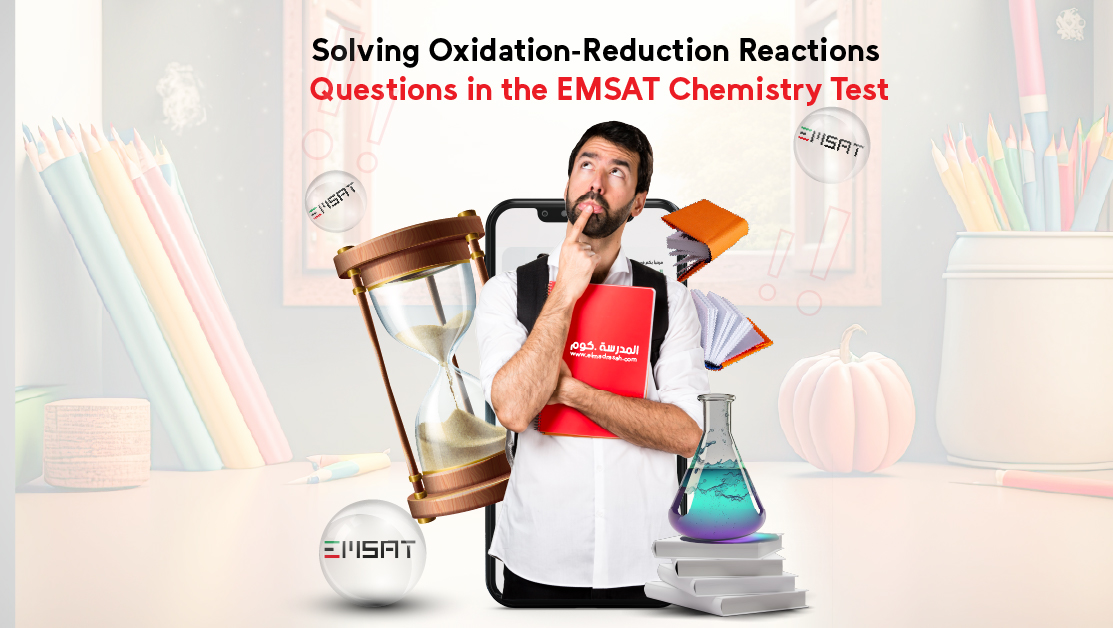
You will face questions about oxidation and reduction reactions in the EMSAT Chemistry exam. They are one of the most important topics in the curriculum. The student must focus on consolidating the concepts and practical applications of these reactions. These questions require an in-depth understanding of the oxidation-reduction process, how it is represented by chemical equilibrium and its types. You can prepare for this test. By helping elmadrasah.com platform achieve a good result in the EMSAT exam in Chemistry.
Oxidation-Reduction Reactions
These reactions depend on the transfer of electrons between inorganic chemistry compounds. Oxidation occurs when electrons are lost from a molecule or atom, while reduction occurs when electrons are gained. There are several ways to represent these reactions, such as changing the oxidation numbers of the elements or using charges.
Importance of studying Oxidation-Reduction Reactions
Studying these interactions is important because of their significant impact on numerous processes in society and daily life. They are used in the manufacture of batteries and power generation, and in industrial production processes and materials technology. The oxidative-reductive reaction is also an essential part of many biological processes, such as metabolism in living organisms.
Therefore, understanding oxidation and reduction reactions is considered one of the basic foundations for preparing for the EMSAT Chemistry test, and the preparation course for this test provided by elmadrasah.com platform may include knowledge of the types of these reactions:
Simple Oxidation-Reduction Reactions
These simple reactions occur between metals and other compounds, such as oxygen and acids. In these reactions, electrons are exchanged between the metal and the other compound, according to what each of them needs.
- Oxidation-Reduction Reactions between metals and oxygen
In these inorganic chemistry reactions, the metal loses electrons and the oxygen gains electrons. This happens when the metal reacts with oxygen in the air to form a metal oxide compound. An example of this is the reaction of iron with oxygen to form iron oxide (rust).
- Oxidation-Reduction Reactions between metals and acids
Here reactions occur between the metal and the acid, and the metal loses electrons and the acid gains electrons. This is that the metal reacts with an acid to form compounds of the metal salt, water, and hydrogen gas. An example of this is the reaction of zinc with sulfuric acid to form zinc sulfate, water, and hydrogen gas.
Complex Oxidation-Reduction Reactions
These complex interactions occur in many different contexts. Here are some key examples of these interactions:
- Oxidation-Reduction Reactions in aqueous solutions:
Many chemical reactions occur in aqueous solutions, including complex Oxidation-Reduction Reactions. For example, one element can undergo an oxidation process by losing electrons, while another can undergo a reduction process by gaining electrons. These reactions usually take place in a neutral or alkaline medium.
- Oxidation-Reduction Reactions in biological processes:
Complex Oxidation-Reduction Reactions occur in many biological processes. For example, photosynthesis in plants is carried out by Oxidation-Reduction Reactions. These reactions also occur in the process of cellular respiration to produce energy in the cells of living organisms.
These complex interactions are important in understanding chemical and biological processes. These reactions occur in nature and in many industries, and play a crucial role in maintaining the balance of chemistry in biological systems.
Synthetic reactions of Oxidation-Reduction Reactions
These reactions are used in many synthetic applications. Here are some examples:
- Oxidation and reduction reactions used in the technique: Oxidation-Reduction Reactions are used in many technologies and industries. For example, these reactions are used in the manufacture of batteries, where a Oxidation-Reduction Reaction occurs inside the battery to generate electrical current. These reactions are also used in the production of inorganic chemicals and the manufacture of electronic products.
- Oxidation-Reduction Reactions in the field of environment: These interactions play an important role in ecology. For example, these reactions are used in wastewater treatment and removal of organic pollutants. These reactions are also used to treat toxic waste and dispose of harmful substances in safe and effective ways.
Bautelier-Volhard rules for Oxidation-Reduction Reactions
Principles of the Bautelier-Volhard rules
Bautelier-Volhard rules are based on estimating the oxidation and reduction of elements in their reactions. It states a basic principle, which is that oxidation reactions occur by decreasing the oxidation number of an element, while reduction reactions occur by increasing the oxidation number of an element.
Calculate the oxidation number change
To calculate the change in the oxidation number of an element in a Oxidation-Reduction Reaction, the oxidation number of that element in the original compound and in the resulting compound must be known. Then the difference between the two numbers is calculated to determine the change in oxidation number.
Bautelier-Volhard rules are widely used in analyzing and interpreting chemical reactions and understanding the nature of the Oxidation-Reduction process. These rules are considered an important tool in organic and inorganic chemistry, as they help determine the oxidation numbers of elements in chemical compounds and understand electrochemistry and oxidation and reduction in many practical applications.
Practical steps to solve Oxidation-Reduction Reactions
- Determine the type of interaction
The first step in solving Oxidation-Reduction Reactions is to determine the type of reaction. A reaction can be an oxidation of one element and a reduction of another, a reduction of one element and an oxidation of another, or an oxidation and reduction of the same element at the same time.
- Calculating the oxidation and reduction of elements
After determining the type of reaction, the oxidation and reduction of the elements involved in the reaction must be calculated. This is done by determining the oxidation number of each element in the compounds involved in the reaction. Then compare the two numbers to determine whether there is an oxidation or reduction process.
Preparing for Emsat chemistry exam
In addition to knowing what oxidation and reduction reactions are and their types in order to prepare for the inorganic chemistry EMSAT exam, you should pay attention to the advice provided by elmadrasah.com teachers.com:
- Solve exercises about oxidation and reduction reactions
To develop practical skills in Oxidation-Reduction Reactions, practical exercises covering many different types of these reactions can be completed. You can start by solving basic exercises and then move on to more complex exercises. It is recommended to review the basic principles of synthetic reactions and use comparison tables to understand the oxidizing and reducing elements in each reaction. It is important to work on increasing practical skills by solving a variety of exercises and examples.
- Review key concepts
After solving practical exercises and studying applied examples, it is recommended to review the main concepts in Oxidation-Reduction Reactions. This includes reviewing the concepts of chemical reactions, Oxidation-Reduction Reactions, electrolyte processes, and cellular forces. Lecture notes and other teaching resources can be used to enhance understanding of these basic concepts. Scientific references and approved books can also be used to delve deeper into these topics.
- Preparing for final exams
In addition to review and review, great attention should be paid to preparing for final exams. Students should develop a structured study plan, which includes setting aside time to study each subject on a regular basis. You should also work on solving practical problems and practicing chemical reactions to enhance practical skills. Past exams and additional exercises can be used to test knowledge and improve EMSAT exam performance.















